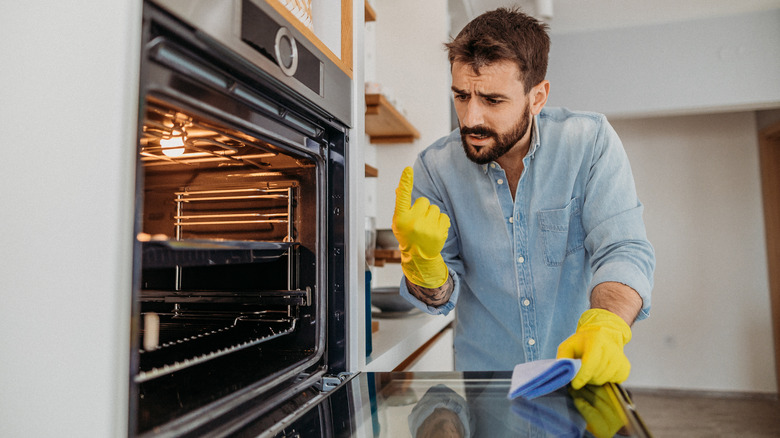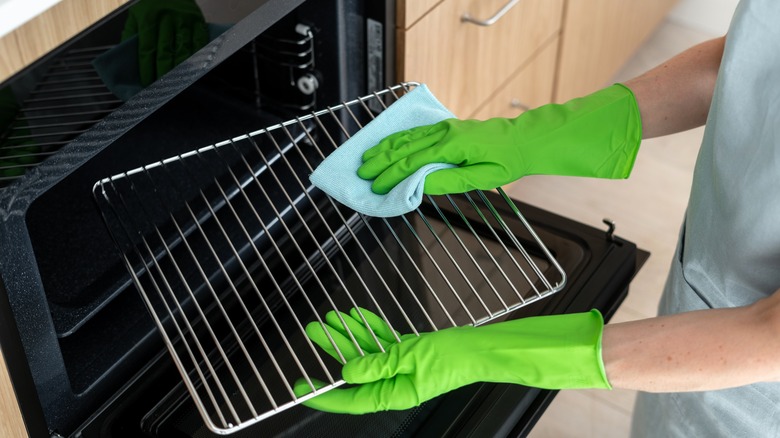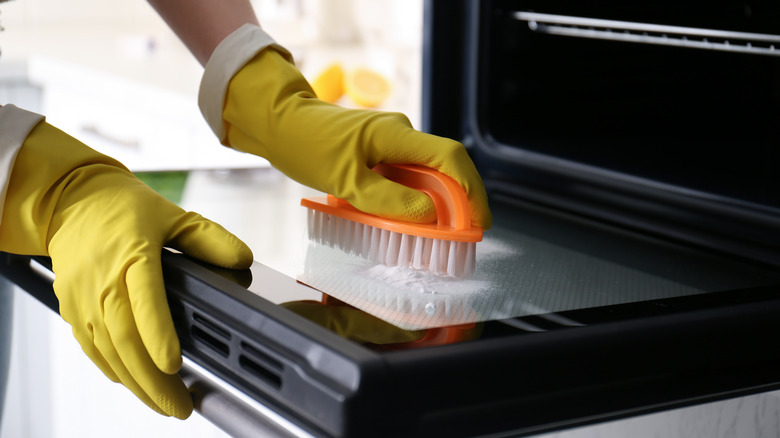The Simple Oven Cleaner Mistake That Could Spell Doom For Your Appliance
Cooking with your oven is a breeze until it's time to clean all the gunk and hardened food from it. We are all guilty of drenching cleaning rags with oven cleaner and wiping down every visible nook and cranny of the appliance. However, you are probably doing your appliance more harm than good. Oven cleaners often contain strong chemicals that some sensitive areas around your stove aren't meant to be exposed to. By lathering them down, you are opening them up to corrosion and hastening wear and tear.
Much like other household cleaning products, oven cleaners are pretty harsh and should be handled with caution. A lot of them contain sodium hydroxide or lye, a highly corrosive compound. Sodium hydroxide is so widely used in soaps and cleaning products because of its effectiveness in dissolving grease, proteins, and grime. This ingredient is not only harsh on your skin but also on metals and their alloys. What else is made of metal? Your oven.
There are several oven cleaner mistakes you don't want to make. If you have a self-cleaning oven, it already sanitizes itself by heating up to almost 1,000 degrees Fahrenheit. The enamel interior of a self-cleaning oven would be damaged by the oven cleaner. Your oven also has a gasket, the silicone seal that keeps it airtight while your food bakes. It is easily broken down by oven cleaner and this means less heat retention and your oven not cooking food evenly or taking forever.
Use the oven cleaner safely by removing cleanable items before spraying
Despite the numerous mistakes that are associated with it, you can use your oven cleaner safely without risking any delicate parts of your oven. The best way to do this is by bringing out the wire racks and the bake trays that have food stuck on them and placing them on old newspapers. Spray them with the cleaner in an open space to minimize the risk of getting that harsh liquid on your gasket and heating elements or even breathing it in. Let this sit for about half an hour before wiping them clean and rinsing thoroughly.
If you must clean splashed food inside your oven, be sure to aim directly at the food and not on the sensitive areas. Leave the oven door closed throughout the waiting period of up to a couple hours before cleaning. Above all, never forget to layer up. Put on your protective gloves and even a mask when you're working with oven cleaner. Yes, you can sustain burns and rashes from the irritating product if you're not careful. Make sure to throw open the kitchen windows, too, so that you don't suffocate from the fumes.
Clean your oven the natural way instead
Oven cleaner is truly the bane of your cooking appliance, so think of the stove and oven's shelf-life before using it. A lot of people don't and then wonder why the metal is rusting and their food spends centuries in there only to come out half-done. There are ways to clean your oven properly using safer, milder household products that you won't have to worry about, like baking soda.
Baking soda is your forever trusty, ever-available best friend who happens to live in your kitchen cabinet. We use it for a variety of things, and it can also be used to clean your oven without the risk of corroding it. It's abrasive enough to mop up grease and food particles without causing damage to the surface of your appliance. However, baking soda is usually a no-no with aluminum, but since your oven is likely made of iron or steel, you're good.
To clean with baking soda, mix ½ cup of it with 3 tablespoons of water to form a paste. Smear this paste around in the oven where those food juices have dripped. Steer clear of the heating element so you don't accidentally get paste inside. You can let this sit for about 20 minutes before grabbing an old toothbrush or sponge and getting to work. Gently scrub until all the grime is lifted and then wipe it clean with a rag soaked in a mixture of three parts water to one part vinegar.


